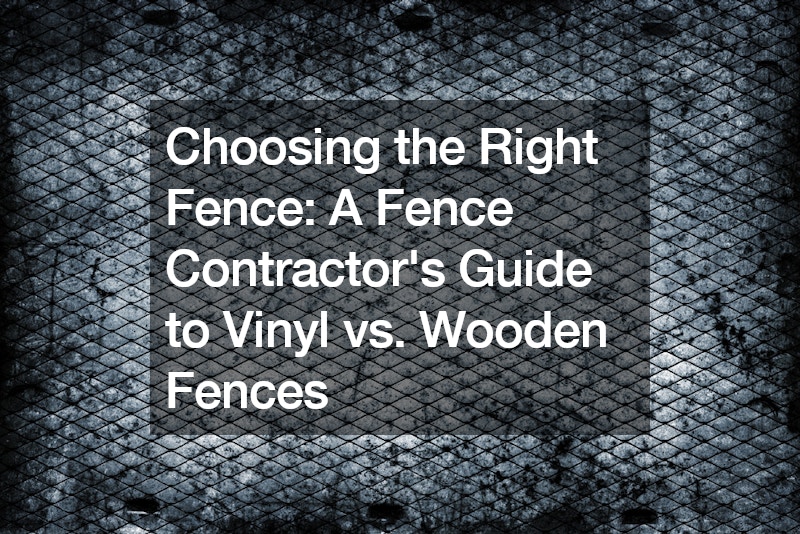
As a fence contractor, I’ve seen countless homeowners grapple with the age-old question: vinyl or wood fencing? Both materials offer distinct advantages, and the best choice ultimately depends on your budget, desired aesthetics, and lifestyle. This guide delves into the key considerations when choosing between vinyl and wood fences, empowering you to make a cost-effective decision that aligns with your needs.
1. Unveiling the Dollar Divide: Initial Costs vs.
Long-Term Value
Let’s be honest: budget is a major factor for most homeowners. Here’s a breakdown of the upfront costs:
Vinyl Fencing: While the initial cost per linear foot of vinyl fencing may be slightly higher than wood, it’s important to consider long-term value.
Wood Fencing: While cheaper upfront, wood requires regular maintenance (staining, repairs) to maintain its appearance and prevent rot. These ongoing costs can add up significantly over time.
2. The Tale of Two Upkeep Routines: Low-Maintenance Magic vs. DIY Diligence
The time and effort required for fence maintenance is another crucial factor:
Vinyl Fencing: Vinyl is a low-maintenance champion. Occasional cleaning with soap and water is usually all that’s needed. It resists weather elements, insects, and rot, minimizing the need for repairs.
Wood Fencing: Wood requires regular maintenance to stay beautiful. Staining or painting is necessary every few years to prevent weathering and fading. Additionally, wood is susceptible to rot and insect damage, potentially requiring repairs or replacements.
3. Aesthetics Unveiled: Achieving Your Dream Backyard Oasis
Your fence plays a significant role in your home’s curb appeal and backyard ambiance:
Vinyl Fencing: Vinyl comes in various styles and colors, mimicking the look of wood grain or offering a clean, modern aesthetic. It can also be adorned with post caps and decorative elements for added visual interest.
Wood Fencing: Wood offers a classic, natural beauty that complements various architectural styles. Staining options allow customization, but the natural color will weather over time.
4. Durability Defined: Weathering the Elements, Year After Year
Fences are an investment, so durability is key:
Vinyl Fencing: Vinyl is highly resistant to weather extremes, including harsh sunlight, rain, snow, and even salt spray in coastal areas. It won’t warp, crack, or rot, ensuring long-lasting performance.
Wood Fencing: Wood is susceptible to warping, cracking, and rot, especially in areas with high humidity or frequent rain. Extreme temperature fluctuations can also be detrimental to wooden fences.
5. The Eco-Conscious Choice: Weighing Environmental Impact
For environmentally conscious homeowners, the impact of each material matters:
Vinyl Fencing: While vinyl is durable, it’s not necessarily eco-friendly. Vinyl production does involve non-renewable resources. However, high-quality vinyl fences can last for decades, minimizing the need for replacements.
Wood Fencing: Wood can be a more sustainable option, especially if sourced from responsibly managed forests. However, ongoing maintenance practices, such as staining with harsh chemicals, can negate some environmental benefits.
6. Beyond the Basics: Special Considerations for Your Project
Here are some additional factors to consider when making your choice:
Local Regulations: Some communities restrict fence materials and heights. Check with your local authorities before making a decision. Pool Safety: Specific safety regulations regarding height and material may apply if your fence surrounds a pool. DIY Skills: Vinyl fences typically require professional installation, while some wood fence styles can be DIY-friendly for handy homeowners. Consider your comfort level with fence construction. 7. The Fence Contractor’s Perspective: A Word on Professional Installation
As a fence contractor, I strongly recommend professional installation for both vinyl and wood fences, especially for complex designs or uneven terrain. Professionals ensure proper post placement, secure fastening, and adherence to building codes, maximizing the fence’s lifespan and aesthetics.
8. The Final Verdict: It’s All About Your Priorities
The right fence choice hinges on your budget priorities, desired level of maintenance, and aesthetic preferences. Here’s a quick summary to help you decide: 9. Beyond the Bottom Line: The Value of a Trusted Fence Contractor
While cost is a significant factor, don’t underestimate the value of hiring a reputable fence contractor. Here’s how they can benefit you:
Expert Guidance: An experienced contractor can assess your property, understand your needs, and recommend the most suitable fence type based on your budget, style preferences, and local regulations.
Quality Materials and Workmanship: Professional contractors use high-quality fence materials and ensure proper installation techniques, maximizing your fence’s lifespan and structural integrity.
Warranty and Support: Reputable contractors offer warranties on their work and materials, providing peace of mind and promptly addressing any issues.
10. Cost-Saving Strategies: Getting the Most Out of Your Fence Project
Here are some tips to ensure you get the most value for your money, regardless of your chosen fence material:
Get Multiple Estimates: Compare quotes from several qualified fence contractors before deciding. Don’t just focus on price; consider the contractor’s experience, reputation, and warranty terms. Plan Your Fence Line Strategically: A straight, well-planned fence line with minimal curves and corners requires less material, reducing overall costs. Consider Fence Height: Taller fences may offer more privacy and security but also require more materials and labor, impacting the price. Evaluate your needs and local regulations to determine the optimal height. Choose the Right Posts: While vinyl posts may seem more expensive up front, they require less maintenance than wooden posts, potentially saving money in the long run. 11. The Future of Fencing: Innovation and Eco-Friendly Options
The fencing industry is constantly evolving. Here are some emerging trends to keep an eye on:
Composite Fences: These fences combine wood fibers with plastic polymers, offering a low-maintenance alternative to wood with a more natural aesthetic. Recycled Vinyl Fences: Sustainable options are becoming available, utilizing recycled vinyl materials for a more eco-conscious choice. Solar-Powered Fence Post Caps: These innovative caps illuminate your fence line at night, adding a touch of style and security while powered by the sun. 12. Conclusion: Your Dream Fence Awaits!
Choosing the right fence is an investment that enhances your property’s value, aesthetics, and security. You can decide between vinyl and wood fencing by considering your budget, lifestyle, and long-term goals. Remember, a reputable fence contractor can be a valuable partner in navigating the process, ensuring a high-quality, cost-effective fence solution that complements your home for years to come.
.




